11 Design Ideas for a Small Narrow Garden
Urban landscapes often present a mosaic of towering buildings and limited open spaces. For many city dwellers, a small, narrow garden becomes a coveted slice of nature—a slender plot tucked between structures or stretching behind terraced houses. While such gardens pose challenges, they also offer unique opportunities for creativity. With thoughtful design and a touch of ingenuity, even the most constricted spaces can be transformed into verdant retreats that defy their modest dimensions. This article explores ten design ideas to inspire and guide the metamorphosis of slim gardens into captivating sanctuaries.
Idea 1: Vertical Garden Walls

Maximizing Vertical Space
When horizontal expansion is impossible, vertical surfaces become invaluable. Walls, fences, and even the sides of buildings can be harnessed to cultivate greenery. By thinking upwards, gardeners can multiply their planting area and introduce layers of texture and color that enrich the visual tapestry.
Types of Vertical Gardens
Possibilities for vertical planting are extensive. Living walls employ modular panels filled with soil and plants, creating a lush, green facade. These systems can host a diverse array of species, from ferns and mosses to flowering perennials and succulents. For a more straightforward approach, pocket planters affixed to walls provide individual compartments for herbs, flowers, or trailing vines. Trellises support climbing plants like clematis, wisteria, or climbing roses, which weave natural tapestries that change with the seasons.
Installation Tips
Successful vertical gardens require careful planning. The weight of soil, plants, and water can be substantial, so it’s essential to ensure that walls or supports are structurally sound. Waterproofing behind the planting area prevents moisture from damaging structures. Irrigation systems, whether simple drip lines or more complex setups, help maintain consistent moisture levels, crucial for vertical plantings that can dry out quickly. Selecting plants suited to the light conditions—shade-loving varieties for north-facing walls, sun-loving species for southern exposures—will enhance the garden’s vitality.
Mirrors Suitable for Gardens

Rustic Wood Mirror
Add rustic charm to your space with our Farmhouse Style Mirror. 9.5×12″ wooden frame with a whitewashed finish creates a retro feel. Sturdy, high-quality construction & high-definition glass for a clear reflection. Perfect for farmhouse decor & beyond.

Arched Decorative Mirror
Reimagine your space with our Arched Paneled Mirror. Premium materials & fine craftsmanship ensure long-lasting quality. Reflects light, creating a brighter & more spacious feel. Perfect for garden walls, vanities, or any room in your home.

Rectangular Rustic Antique Mirror
Elevate your space with our Vintage Style Mirror. 11×9.4″ gold frame adds a touch of elegance to any room. Perfect for bathrooms, bedrooms, entryways or even outside in the garden. Multifunctional & wall mountable. Makes a beautiful and functional addition.
Amazon
Idea 2: Mirror Magic
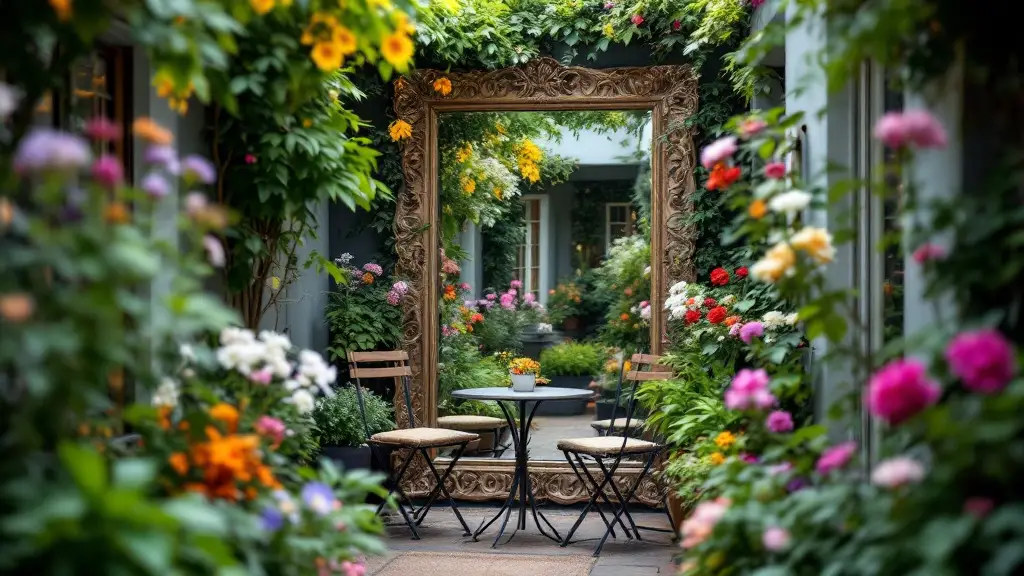
Expanding Space Visually
Mirrors have long been used by interior designers to create the illusion of space, and they can work the same magic in gardens. Reflective surfaces bounce light around, brighten shaded areas, and double the visual impact of plants and features.
Placement Strategies
Strategic placement is key to harnessing the benefits of mirrors in the garden. Position mirrors to reflect a beautiful vista or a particularly striking plant arrangement. Angling them slightly prevents awkward reflections and reduces the risk of birds flying into them. Framing mirrors with materials that match the garden’s aesthetic—such as rustic wood for a cottage feel or sleek metal for a contemporary space—integrates them seamlessly into the environment.
Mirror Selection
Outdoor mirrors must withstand the elements. Opt for mirrors specifically designed for exterior use, constructed with durable, weather-resistant materials. Antique or patinated finishes can add character and soften reflections, blending the mirror into the garden’s fabric.
Idea 3: Slimline Water Features
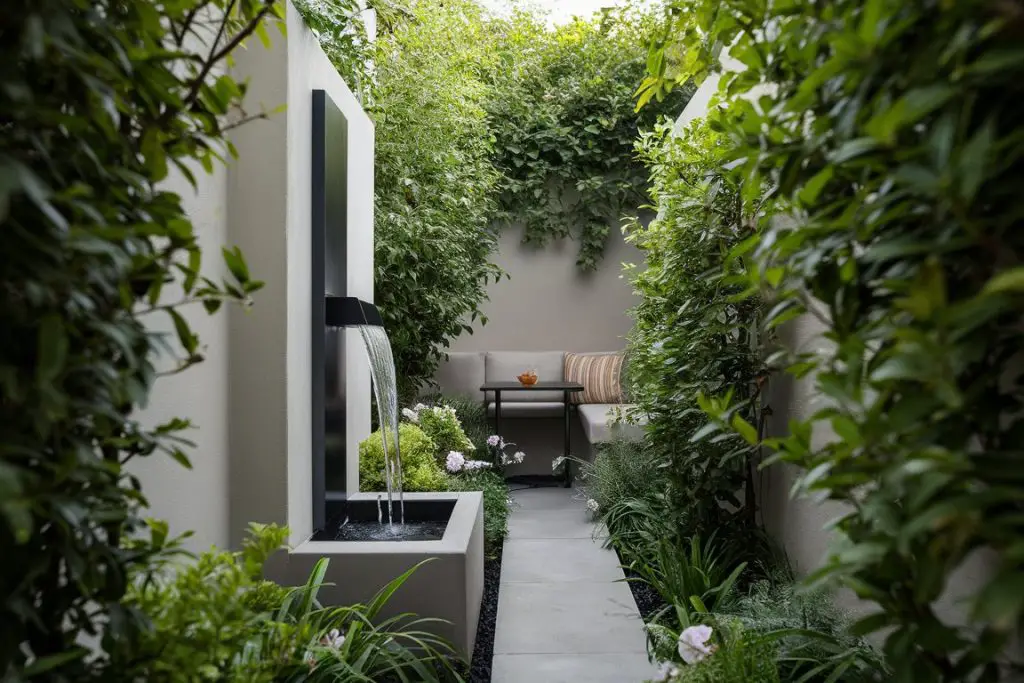
Enhancing Ambiance
The gentle sound of water introduces a soothing element that enhances the sensory experience of a garden. In small spaces, appropriately scaled water features can become focal points that bring tranquility and a sense of luxury.
Space-Saving Designs
Numerous designs suit narrow gardens. Wall-mounted fountains cascade water down vertical surfaces, creating movement and sound without occupying ground space. Narrow rills—shallow channels where water flows—can run along pathways or between planting beds, adding a dynamic element. Bubbling urns or stone spheres provide the sound of flowing water in a compact footprint.
Installation Considerations
When incorporating water features, consider practicalities such as access to electricity for pumps and the availability of water sources. Recirculating systems are efficient, requiring only an initial fill and occasional top-ups. Maintenance is essential to prevent algae buildup and keep the water clear. Safety is also a concern, especially for households with young children; choosing designs without open pools minimizes risks.
Idea 4: Built-In Seating with Storage
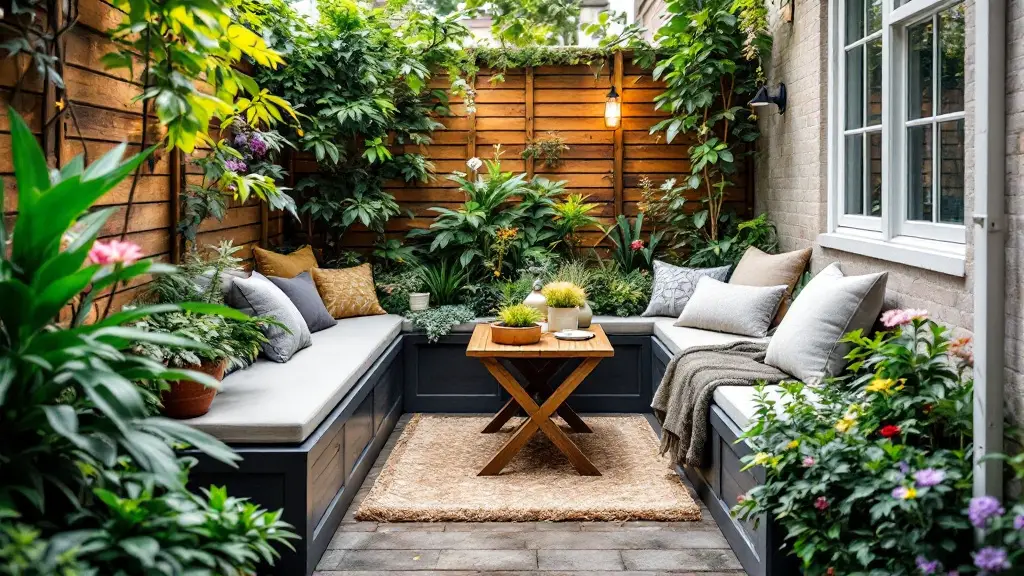
Dual-Purpose Furniture
In a garden where every inch counts, furniture that offers multiple functions is a smart choice. Built-in seating not only provides a place to relax but can also incorporate storage solutions that keep the space tidy and uncluttered.
Design Options
There are myriad ways to integrate seating into the garden’s structure. A wooden bench built along a fence line can have lift-up seats revealing storage beneath for cushions, tools, or toys. Stone or brick seating can double as retaining walls for raised beds, blending functionality with structural support. Curved benches soften the lines in a rectangular garden, introducing a sense of flow.
Customization
Tailoring built-in furniture to the garden’s dimensions and style ensures harmony. Materials should complement existing elements—timber for a natural feel, metal for a modern touch, or reclaimed materials for a rustic vibe. Adding personal touches, like colorful cushions or bespoke carvings, imbues the space with character.
Idea 5: Layered Planting for Depth
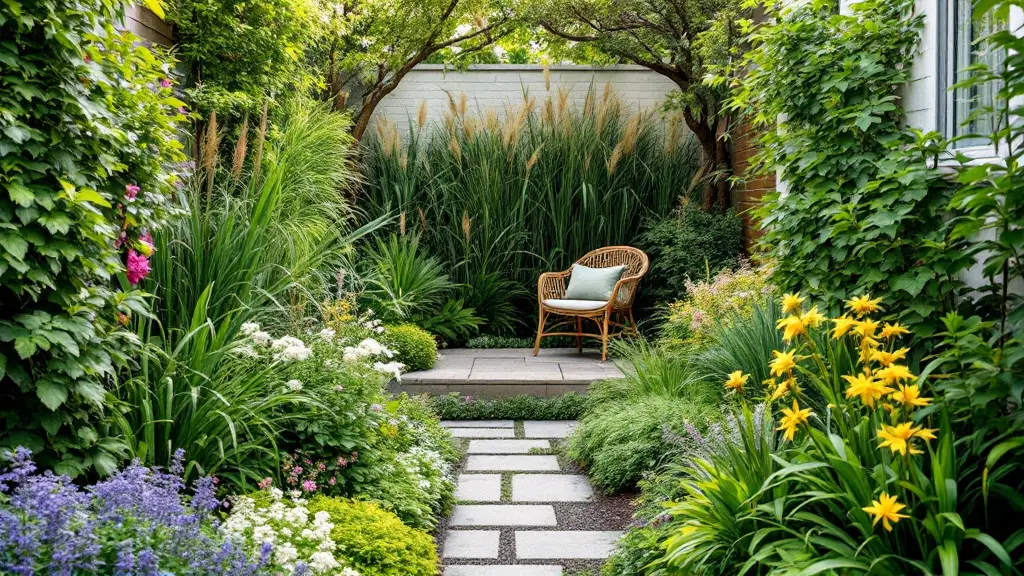
Creating Visual Interest
Layered planting is a technique that orchestrates plants of different heights, textures, and colors to create depth and complexity. In a narrow garden, this approach can counteract the confined feeling by drawing the eye through various levels of interest.
Plant Selection
The success of layered planting hinges on thoughtful plant choices. Groundcovers like creeping thyme or sedums can carpet the lowest level, while mid-height perennials such as lavender or salvias provide bulk and color. Taller elements might include ornamental grasses or slender trees like birch or Japanese maple. Texture is equally important; mixing feathery foliage with broad leaves and spiky forms adds richness.
Seasonal Considerations
A garden that evolves with the seasons maintains interest year-round. Spring bulbs bring early color, followed by summer perennials and autumn foliage. Evergreens provide structure in winter. Including plants with varied bloom times ensures that the garden’s tapestry is continually refreshed.
Idea 6: Zoning with Flooring
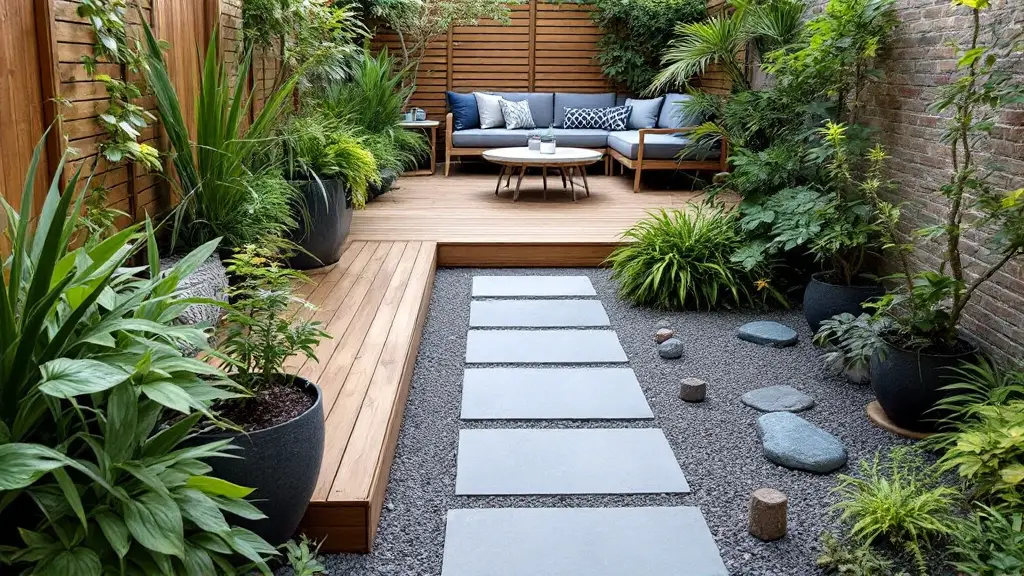
Defining Areas
Even in a small garden, creating distinct zones can enhance functionality and the perception of space. Different flooring materials can delineate areas for dining, lounging, or gardening, making the garden feel larger and more purposeful.
Material Choices
The choice of materials influences both aesthetics and practicalities. Decking offers warmth and is comfortable underfoot, suitable for seating areas. Stone pavers bring a sense of permanence and can complement traditional or contemporary designs. Gravel is cost-effective and provides excellent drainage, ideal for pathways or relaxed seating spots. Patterned tiles introduce artistry and can evoke Mediterranean or Moroccan styles.
Continuity and Flow
While zoning creates distinction, maintaining visual continuity prevents the garden from feeling fragmented. Using a consistent color palette or repeating materials in different zones ties the space together. Aligning pathways and sightlines encourages movement and exploration.
Idea 7: Hanging Gardens
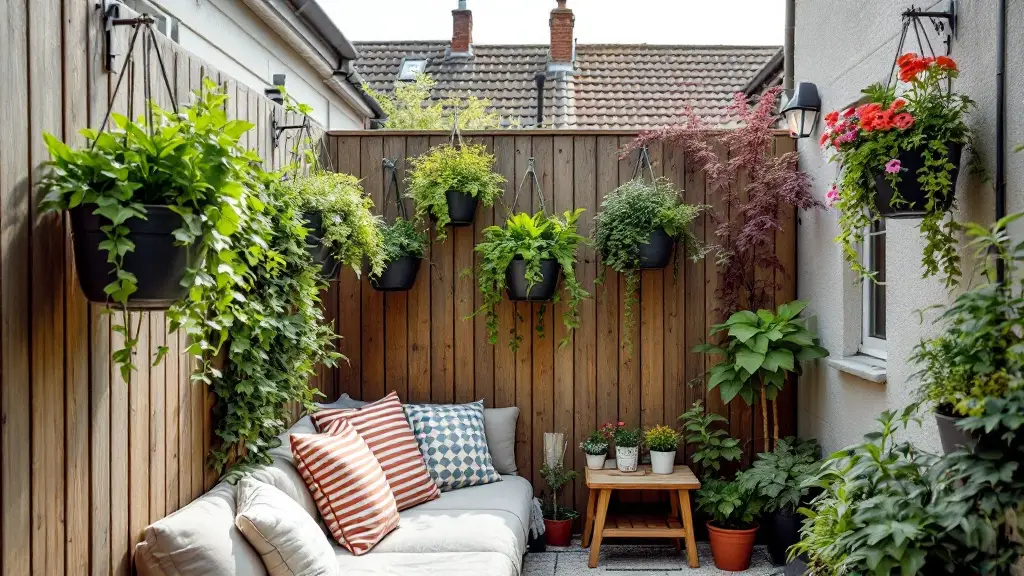
Utilizing Overhead Space
The vertical dimension offers untapped potential in narrow gardens. By suspending plants above ground level, it’s possible to introduce greenery without occupying floor space, adding layers of interest and softness.
Types of Hanging Planters
Hanging planters come in a variety of styles to suit different aesthetics. Traditional baskets lined with coir are classic and versatile. Contemporary designs might feature sleek metal or geometric shapes. For a more eclectic look, repurpose items like tin cans, teapots, or shoes as quirky planters. Self-watering hanging systems can reduce maintenance demands.
Plant Suggestions
Plants suited to hanging gardens often have trailing habits. Petunias, verbena, and lobelia offer cascades of color. Herbs like thyme, oregano, or trailing rosemary provide fragrance and culinary uses. For shaded areas, ferns and ivy thrive and add lushness.
Idea 8: Color Schemes and Themes
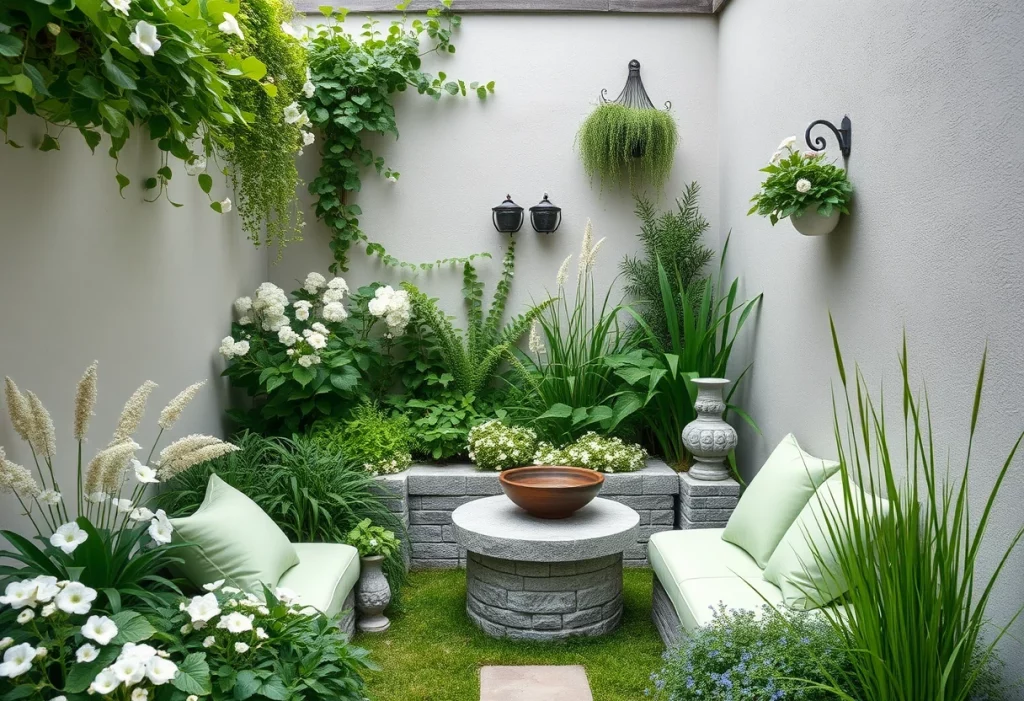
Impact of Color
Color profoundly affects how a space is perceived. In a small garden, color can be used strategically to manipulate the sense of size and create specific moods.
Monochromatic vs. Contrasting Palettes
A monochromatic palette—using different shades of a single color—can unify the space and create a calming atmosphere. For example, a garden dominated by greens, with variations from lime to emerald, feels cohesive and soothing. Conversely, employing contrasting colors like purple and yellow or blue and orange adds energy and draws attention to focal points.
Themed Gardens
Adopting a theme provides direction and coherence. A Mediterranean garden might feature terracotta pots, lavender, and olive trees, evoking sun-drenched landscapes. A Japanese-inspired garden could include bamboo, maples, gravel, and water elements, emphasizing tranquility and minimalism. Themes guide plant selection, materials, and decorative elements, resulting in a harmonious design.
Idea 9: Diagonal Lines and Shapes
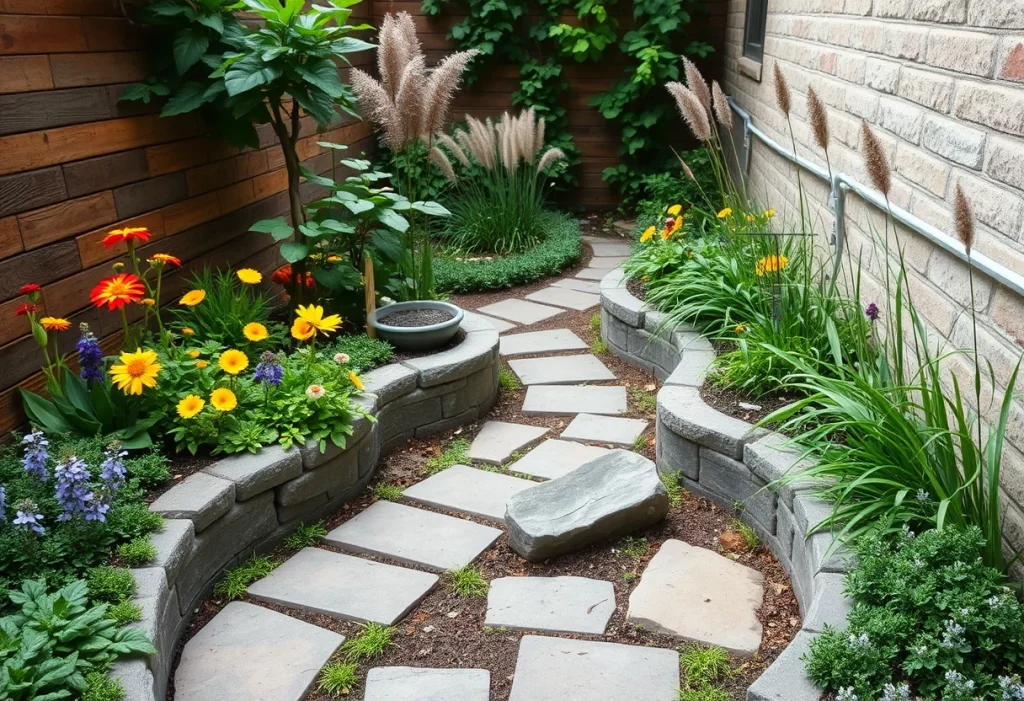
Breaking Up Linear Space
Straight lines emphasize the narrowness of a garden. Introducing diagonal lines and shapes disrupts this linearity, creating movement and making the space feel more dynamic.
Pathways and Planting Beds
Laying pathways at an angle diverts the eye and extends the journey through the garden. Curved or irregularly shaped planting beds add intrigue and soften rigid boundaries. Stepping stones placed in a staggered pattern encourage meandering.
Visual Tricks
Optical illusions can enhance the perception of space. Wider planting at the front of the garden tapering to narrower beds at the back can make the area seem longer. Placing larger plants toward the front and smaller ones behind can create depth, similar to techniques used in painting.
Idea 10: Creative Lighting
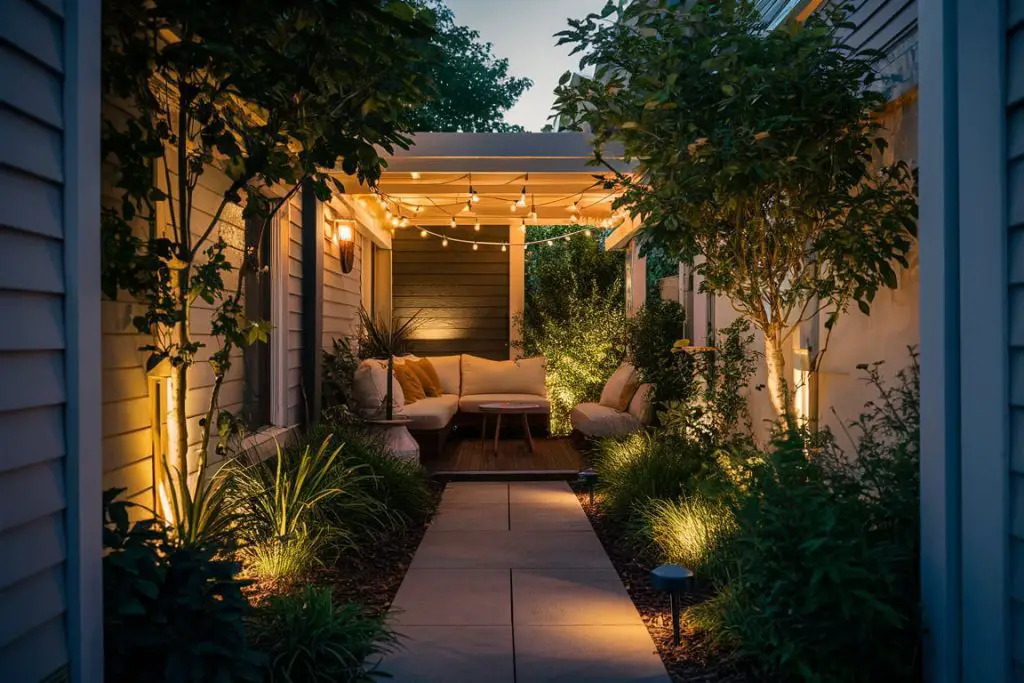
Extending Usability
Lighting transforms a garden after dark, extending its use and revealing new dimensions. Thoughtful illumination highlights textures and forms that might go unnoticed during the day.
Types of Lighting
A layered lighting approach balances functionality and ambiance. Ambient lighting provides general illumination; options include overhead string lights or lanterns. Task lighting focuses on specific areas like a dining table or reading nook. Accent lighting draws attention to features such as a sculptural plant, a water feature, or architectural details. Solar-powered lights are environmentally friendly and easy to install, while low-voltage systems offer consistent performance.
Highlighting Features
Uplighting trees or washing walls with light adds drama. Downlighting from wall-mounted fixtures creates intimate spaces. Incorporating colored lights can set a mood, though subtlety is key to maintaining elegance.
Idea 11: Overhead Structures and Canopies
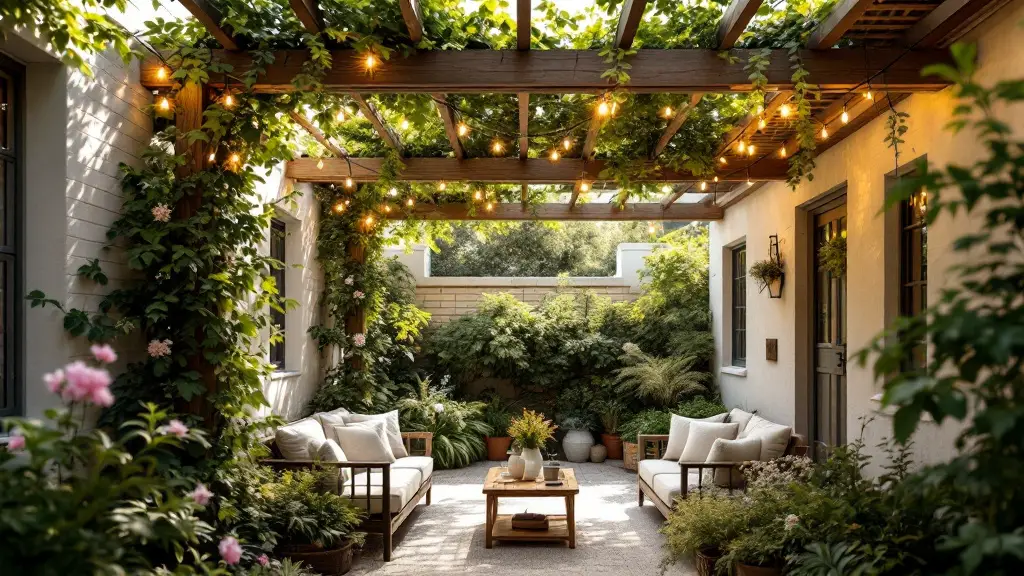
Creating an Outdoor Room
Introducing overhead elements can redefine a narrow garden, transforming it from a simple passageway into a defined outdoor room. Pergolas, arbors, and trellises not only add architectural interest but also create a sense of enclosure that makes the space feel more intimate and purposeful.
Benefits of Overhead Structures
Overhead features provide several practical advantages. They offer shade, making the garden more comfortable during hot weather. They also support climbing plants, which can envelop the structure in greenery, flowers, and even fruit. This vertical growth enhances the garden’s lushness without consuming ground space.
Design Considerations
When selecting an overhead structure, scale is paramount. The design should complement the garden’s proportions, avoiding elements that overpower the space. Materials like wood, metal, or even bamboo can be chosen to match the garden’s aesthetic. An open lattice design allows light to filter through, preventing the area from feeling too enclosed.
Enhancing with Lighting and Accessories
Adding lighting to overhead structures extends the garden’s usability into the evening hours. String lights woven through beams or lanterns hung at varying heights create a magical ambiance. Hanging accessories like wind chimes, bird feeders, or small planters add layers of interest and personalize the space.
Time to Start Your Project
Transforming a small narrow garden is a creative endeavor that marries aesthetics with practicality. These ten design ideas provide a toolkit for reimagining limited spaces, turning constraints into opportunities for innovation. By layering strategies—combining vertical gardens with mirrored surfaces, or integrating built-in seating with zoned flooring—gardeners can craft personalized spaces that reflect their tastes and lifestyles.
The potential of small gardens lies not in their size but in the experiences they offer. With careful planning and a willingness to experiment, even the most modest plot can become a cherished haven. These intimate spaces invite us to engage more closely with nature, to appreciate the nuances of light, texture, and growth. A small garden offers a place to slow down, to observe, and to find delight in the details.
